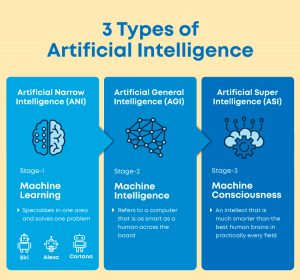 The Three Types of AI
The Three Types of AI
We can sort artificial intelligence into narrow, general, and super intelligence. Artificial narrow intelligence is designed to be useful for one certain task, skill, or problem. ANI can come close to human capabilities, and potentially surpass them, but ANI only works under limited parameters. ANI is the only artificial intelligence that exists today. One example of artificial narrow intelligence is Jasper, an AI copywriter which can create content instantly, disrupting many creative fields such as blogging and advertising. Artificial general intelligence is AI with human capacities for cognitive functioning and reasoning, but across many areas. AGI is still theoretical, but would be, for example, a version of Jasper that could not only create copy, but deconstruct the meaning behind this copy. It is difficult to wrap your mind around the differences between AGI and ANI, as the difference lies in the specific cognitive functions that define humans like reasoning and processing, but AGI is basically a more human and adaptable version of ANI. Artificial super intelligence is artificial intelligence that completely surpasses human capabilities. Again, it is difficult to conceptualize what this might actually look like, because we are so far away from this goal, but additional capabilities of ASI past AGI would be the ability to make rational decisions and form emotional relationships. Using the Jasper example, perhaps this might look like a version that could create copy, understand the emotional meaning behind the copy, and then make a decision between two different versions based on which is more emotionally resonant for a specific ad campaign.
Leave a Reply
You must be logged in to post a comment.